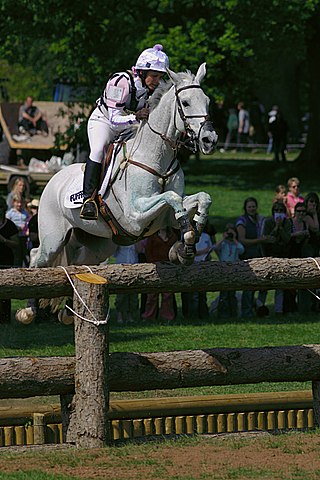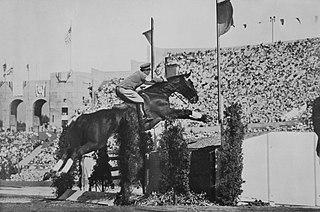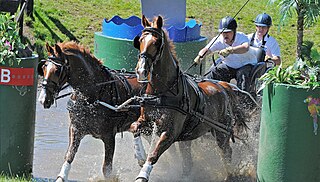Show jumping is a part of a group of English riding equestrian events that also includes eventing, hunters, and equitation. Jumping classes are commonly seen at horse shows throughout the world, including the Olympics. Sometimes shows are limited exclusively to jumpers. Sometimes jumper classes are offered in conjunction with other English-style events. Sometimes, show jumping is but one division of a very large, all-breed competition that includes a very wide variety of disciplines. Jumping classes may be governed by various national horse show sanctioning organizations, such as the United States Equestrian Federation or the British Showjumping Association. International competitions are governed by the rules of the International Federation for Equestrian Sports.

Eventing is an equestrian event where a single horse and rider combine and compete against other competitors across the three disciplines of dressage, cross-country, and show jumping. This event has its roots in a comprehensive cavalry test that required mastery of several types of riding. The competition may be run as a one-day event (ODE), where all three events are completed in one day or a three-day event (3DE), which is more commonly now run over four days, with dressage on the first two days, followed by cross-country the next day and then show jumping in reverse order on the final day. Eventing was previously known as Combined Training, and the name persists in many smaller organizations. The term "Combined Training" is sometimes confused with the term "Combined Test", which refers to a combination of just two of the phases, most commonly dressage and show jumping.

The Kentucky Three-Day Event, currently the Land Rover Kentucky Three-Day Event due to sponsorship, is an eventing competition held at the Kentucky Horse Park in Lexington, Kentucky. Land Rover Kentucky is a CCI5*-L eventing competition. Five stars is the highest level of competition in the sport, the same level of competition as Eventing at the Olympics and the World Equestrian Games. The event is sponsored by Land Rover. Prize money of $400,000 is distributed among the top placings with $110,000 as well as a Rolex watch awarded to the first place horse and rider.The winning rider also gets a 12-month lease of a Land Rover
Equestrian competitions at the 1968 Summer Olympics in Mexico City, Mexico featured team and individual competitions in show jumping, eventing, and dressage. Mexico City proved a challenging site since it was 2,300 meters above sea level, resulting in 30% less oxygen in the air. The horses at the 1955 Pan American Games, which was also held in Mexico City, arrived a few weeks before the Games to adjust, but had difficulty in the competition. However, racehorses that competed at the same location and who were shipped in the day before, and left the day after the race, performed fine. It was discovered that although horses would adjust immediately to the high altitude during the first few days after arrival, they showed weakness and decreased performance around Day 10, which continued to Day 20. Therefore, nations were advised to ship in horses 3–4 weeks before the competition, which would allow them time to recover from the long travel, as well as adjust to the difference in altitude. Argentina, Ireland, and the USSR were the first to ship horses over, who arrived mid-September. France and Germany were the last countries to send their horses, who arrived 28 September 20 days before the competition was to start.

The equestrian program at the 1912 Summer Olympics in Stockholm, included five medal events. There were individual competitions in dressage, eventing, and show jumping. Team scores were also gathered and medals awarded for teams in the eventing and jumping competitions. Equestrian had been absent from the Olympic program since the 1900 Summer Olympics, making the 1912 Games the second time the sport was featured. Ten nations competed: Belgium, Chile, Denmark, France, Germany, Great Britain, Norway, Russia, Sweden, and the USA. Only Sweden and Germany were able to supply a full team for all three disciplines, with several countries having several riders and horses used in two or even all three disciplines. A total of 88 entries ran in the three events, with 62 riders and 70 horses.

The equestrian events at the 1932 Los Angeles Summer Games included dressage, eventing, and show jumping. The competitions were held from 10 to 14 August 1932. Due to the Great Depression, only 31 entries from 6 nations competed—which was to be the lowest participation of any Olympic Games.

The equestrian events at the 1936 Berlin Summer Olympics included dressage, eventing, and show jumping. All three disciplines had both individual and team competitions. The host country, Germany, had a stellar year, winning both individual and team gold in every equestrian event, as well as individual silver in dressage. The competitions were held from 12 to 16 August 1936. Moderately priced tickets meant huge crowds at all equestrian events, with 15,000–20,000 spectators at any time during the dressage competition, 60,000 on the endurance day of eventing, and 120,000 for the Nations Cup in jumping.
The equestrian events at the 1976 Summer Olympics in Montreal included show jumping, dressage and eventing. All three disciplines, except for the Nations Cup, were held at the equestrian stadium in Bromont, which had a capacity of 15,000 spectators, and the cross-country and steeplechase were also nearby. Building this stadium provided some headache for the Organizing Committee after the original estimate of 1 million Canadian dollars increased to CAD 4,425.
The equestrian events at the 1948 London Summer Olympics included dressage, eventing, and show jumping. All three disciplines had both individual and team competitions. The competitions were held from 9 to 14 August 1948, with the first five days held in the military complex at Aldershot, the endurance day on the army grounds of Aldershot at Tweseldown, and the jumping at the Empire Stadium in Wembley. World War II resulted in a greatly reduced number of competitors, including the absence of Germany, although Brazil made its first appearance in the equestrian events. 103 entries from 17 nations competed. The youngest participant was Aëcio Coelho from Brazil at 23 years old, while the oldest rider was the Italian Alessandro, Count Bettoni Cazzago, at 55 years old.
The equestrian events at the 1956 Summer Olympics were held in Stockholm due to the Australian quarantine regulations and included dressage, eventing, and show jumping. All three disciplines had both individual and team competitions. The competitions were held from 11 to 17 June 1956 at Stockholm Olympic Stadium. There were 158 entries from 29 National Olympic Committees: Argentina, Australia, Austria, Belgium, Brazil, Bulgaria, Cambodia, Canada, Denmark, Egypt, Finland, France, Germany, Great Britain, Hungary, Ireland, Italy, Japan, Netherlands, Norway, Portugal, Romania, Soviet Union, Spain, Sweden, Switzerland, Turkey, USA and Venezuela. This would be the first appearance for Australia, Cambodia and Venezuela in equestrian events.
The equestrian events at the 1972 Summer Olympics in Munich included show jumping, dressage and eventing. All three disciplines had both individual and team competitions. The equestrian competitions were held at 3 sites: an existing equestrian facility at Riem for the individual show jumping and eventing competitions, the Olympic Stadium in Munich for the Nations Cup, and Nymphenburg, a Baroque palace garden, for the sold-out dressage. 179 entries, including 31 women, competed from 27 countries: Argentina, Australia, Austria, Belgium, Bolivia, Bulgaria, Brazil, Canada, Chile, Denmark, German Democratic Republic (GDR), France, Federal Republic of Germany (FRG), Great Britain, Hungary, Ireland, Italy, Japan, Mexico, the Netherlands, Poland, Portugal, Soviet Union, Spain, Sweden, Switzerland, and the USA. The youngest participant was Kurt Maeder from Switzerland at 19 years old, while the oldest rider was Lorna Johnstone from Great Britain at 70 years old.

The equestrian events at the 1964 Summer Olympics in Tokyo included show jumping, dressage and eventing. All three disciplines had both individual and team competitions. The competitions were held from 16 to 24 October 1964. These events took place at Karuizawa, which would become the first city to host Summer and Winter Olympic event when it hosted the curling events for the 1998 Winter Olympics in Nagano.

Combined driving is an equestrian sport involving carriage driving. In this discipline, the driver sits on a vehicle drawn by a single horse, a pair or a team of four. The sport has three phases: dressage, cross-country marathon and obstacle cone driving — patterned after the mounted equestrian sport of eventing. It is one of the ten international equestrian sport horse disciplines recognized by the Fédération Équestre Internationale (FEI). Combined driving became an FEI discipline in 1970 when Prince Philip, Duke of Edinburgh, the then-president of FEI, produced the first rule book.
Giltedge was a 17 hands Irish Sport Horse that was ridden by American David O'Connor at the international level in the sport of eventing.

Equestrian sports were first included in the Olympic Games in the Summer Olympics of 1900 in Paris. They were again included in 1912, and have been included in every subsequent edition of the Games. The Olympic equestrian disciplines are dressage, eventing, and show-jumping. In each discipline, both individual and team medals are awarded. Women and men compete on equal terms.
Concours de Saut International is a ranking system for the equestrian competition show jumping. All CSI events are approved by the international governing body of equestrian sport, the FEI.

Lucinda Fredericks is an equestrian athlete who competes in eventing. Having formerly competed for Great Britain, she now represents Australia. Riding Headley Britannia, she has won three CCI 4* events; winning Burghley in 2006, Badminton in 2007 and Rolex Kentucky in 2009. She won an Olympic silver medal in the team event at Beijing 2008, and also competed at the 2012 London Olympics.

The Equestrian events included three disciplines: dressage, eventing, and show jumping, and were held at the Deodoro Military Club.
The individual eventing competition of the equestrian events at the 2015 Pan American Games took place July 17–19 at the Caledon Equestrian Park. The cross-country portion of eventing took place at nearby Will O' Wind Farm, which is located in Mono. The eventers complete a 3-star level dressage test, stadium, and cross-country course. Eventing consisted of three phases: dressage, cross-country, and show-jumping. Scores from each phase were converted into penalty points, which were summed to give a score. For each rider, the best three scores in each phase counted towards the final score. In the dressage portion, the pair performed in front of three judges. The judges gave marks of between 0 and 10 for each of ten required elements; the scores for the judges were averaged to give a score between 0 and 100. That score was then subtracted from 100 and multiplied by 1.5 to give the number of penalty points.

Rotational falls occur when a horse falls in such a manner as to somersault before landing on its back. It is of particular concern in the sport of eventing, especially in the cross-country phase of the competition. These falls can cause grave injuries and in the past have resulted in fatalities; such fatalities have spiked in recent years, prompting investigations and movements worldwide to increase the safety for participants.










